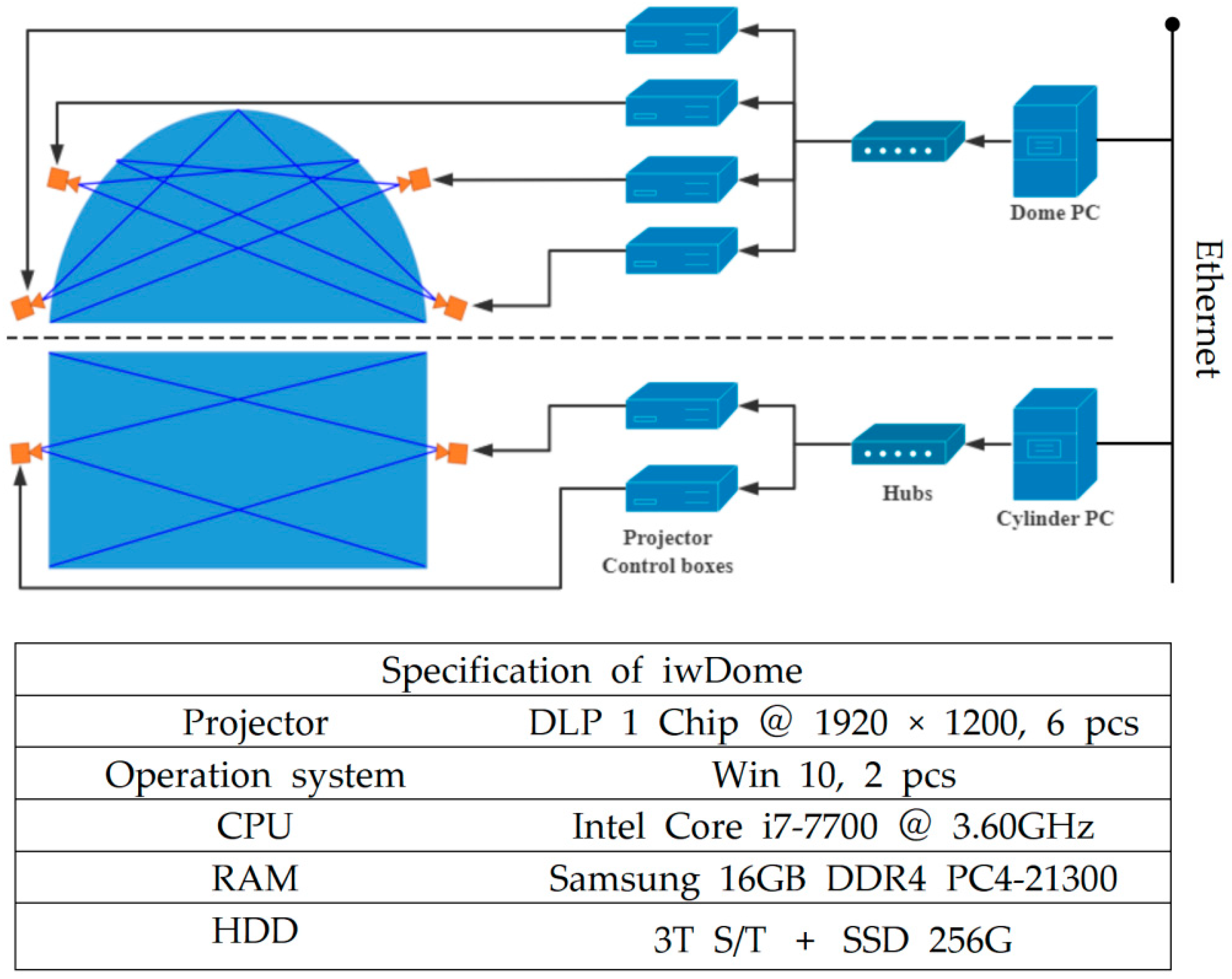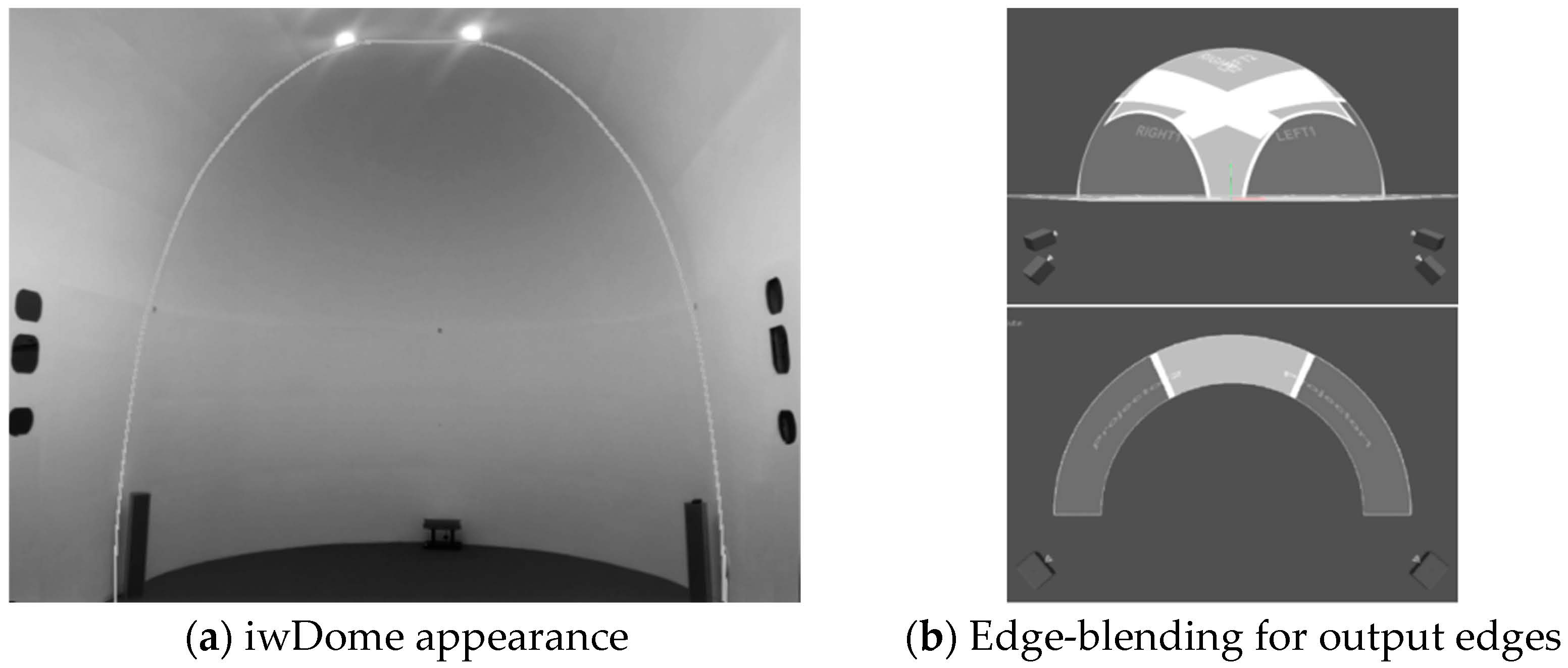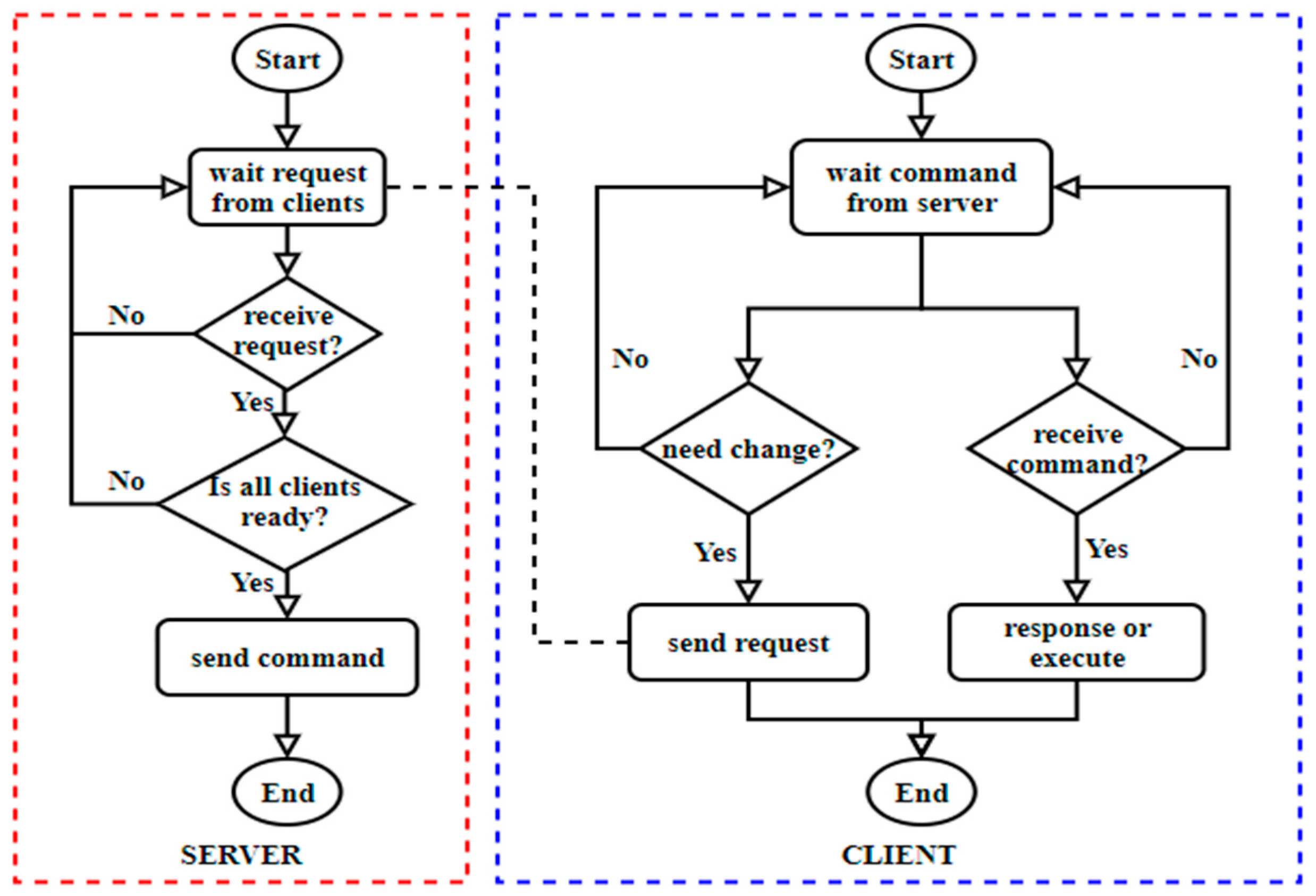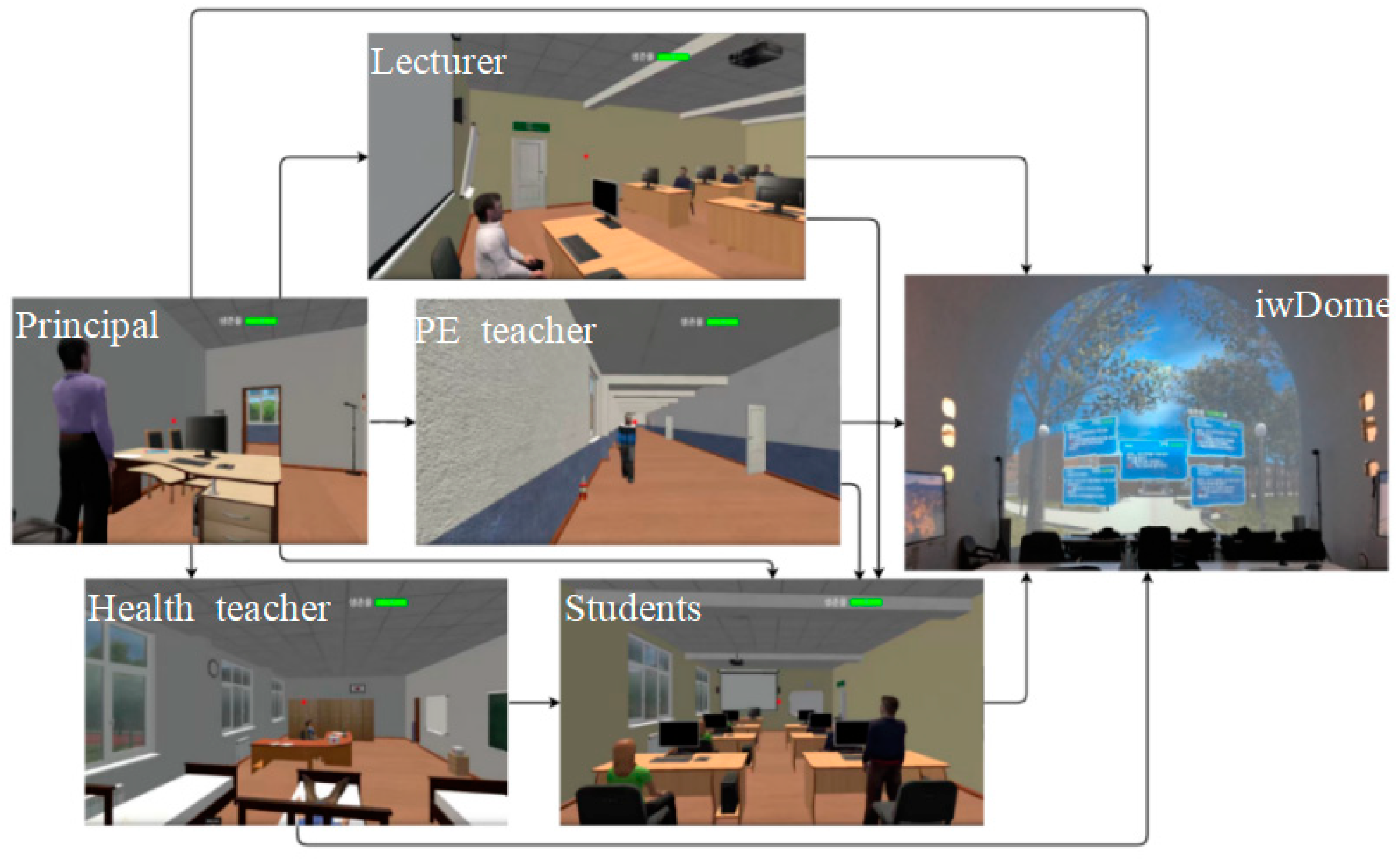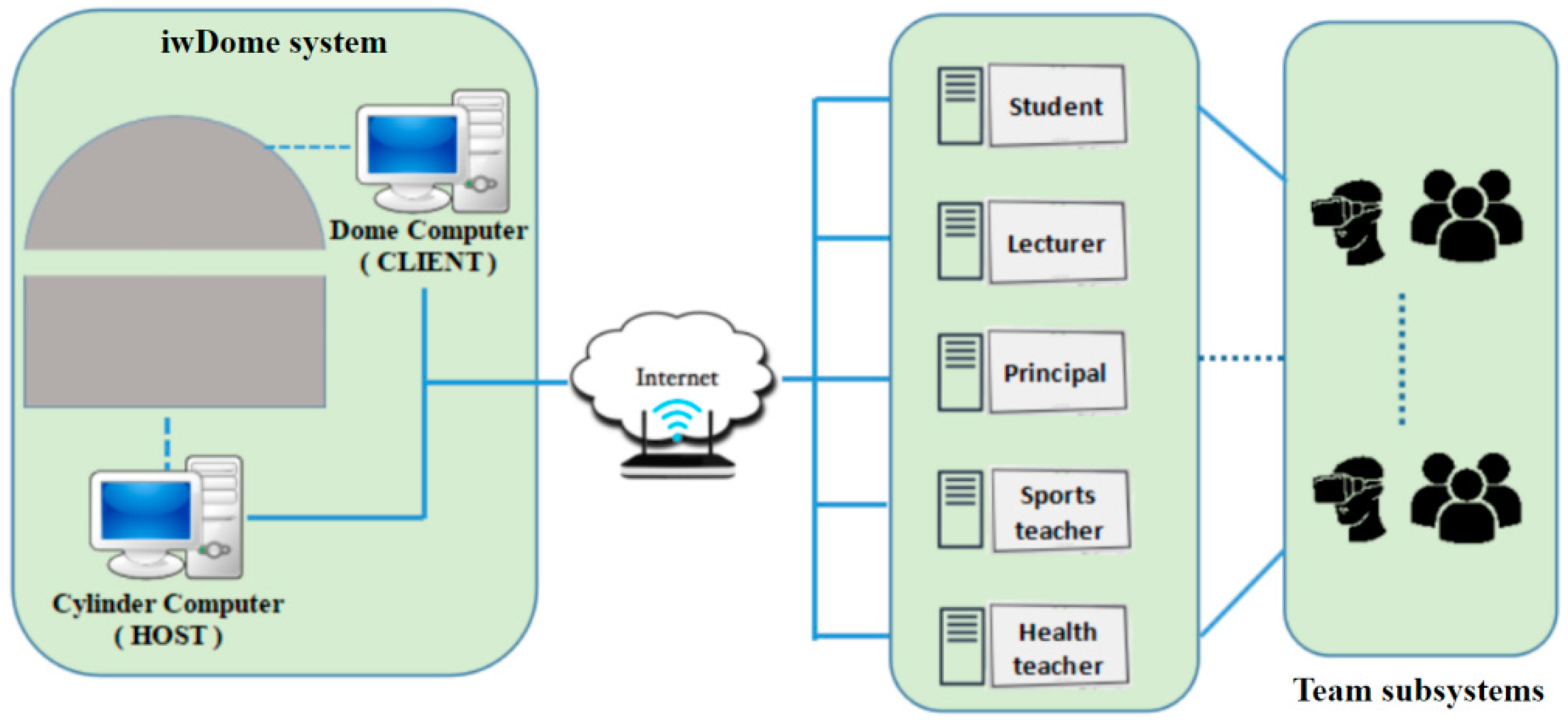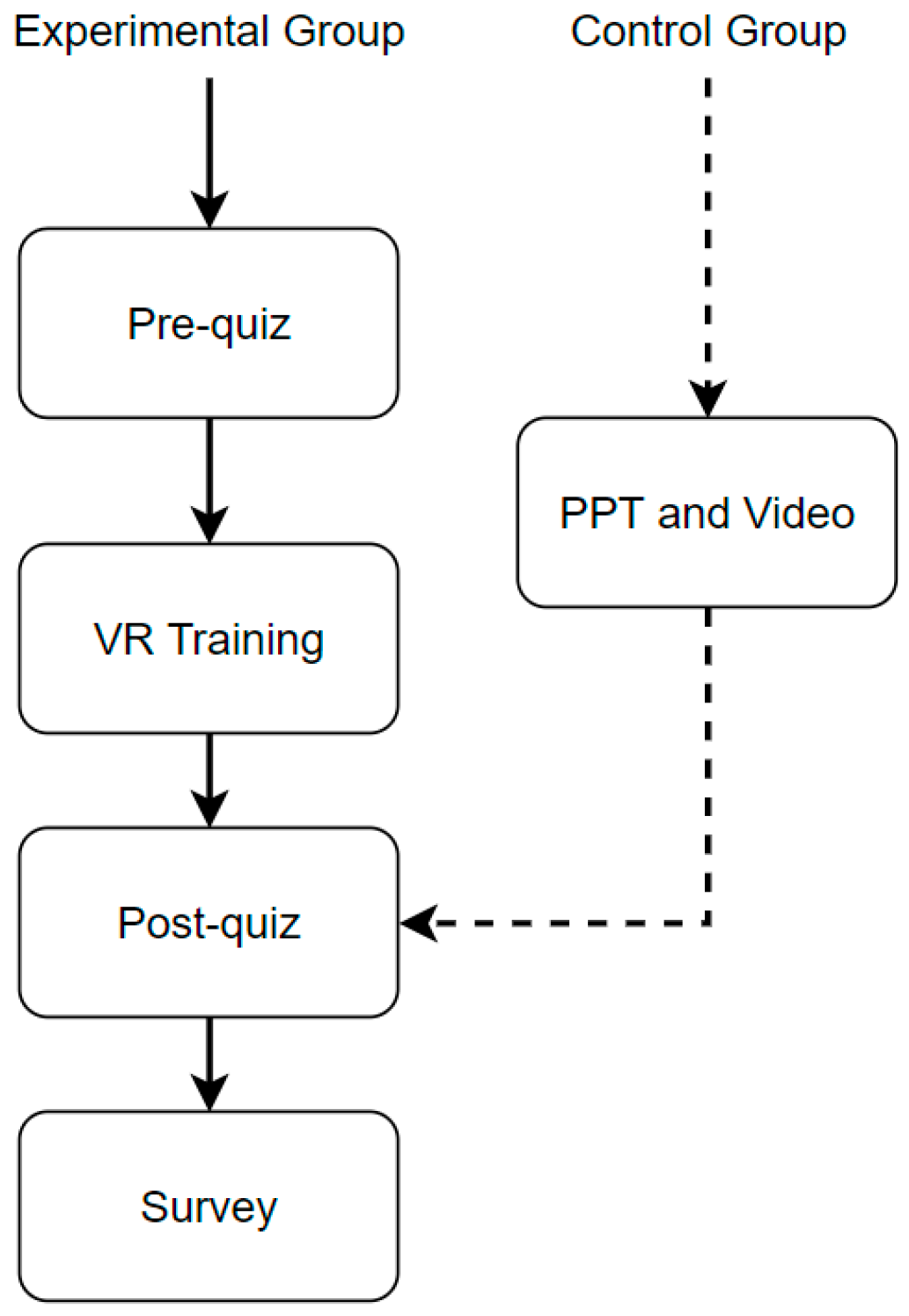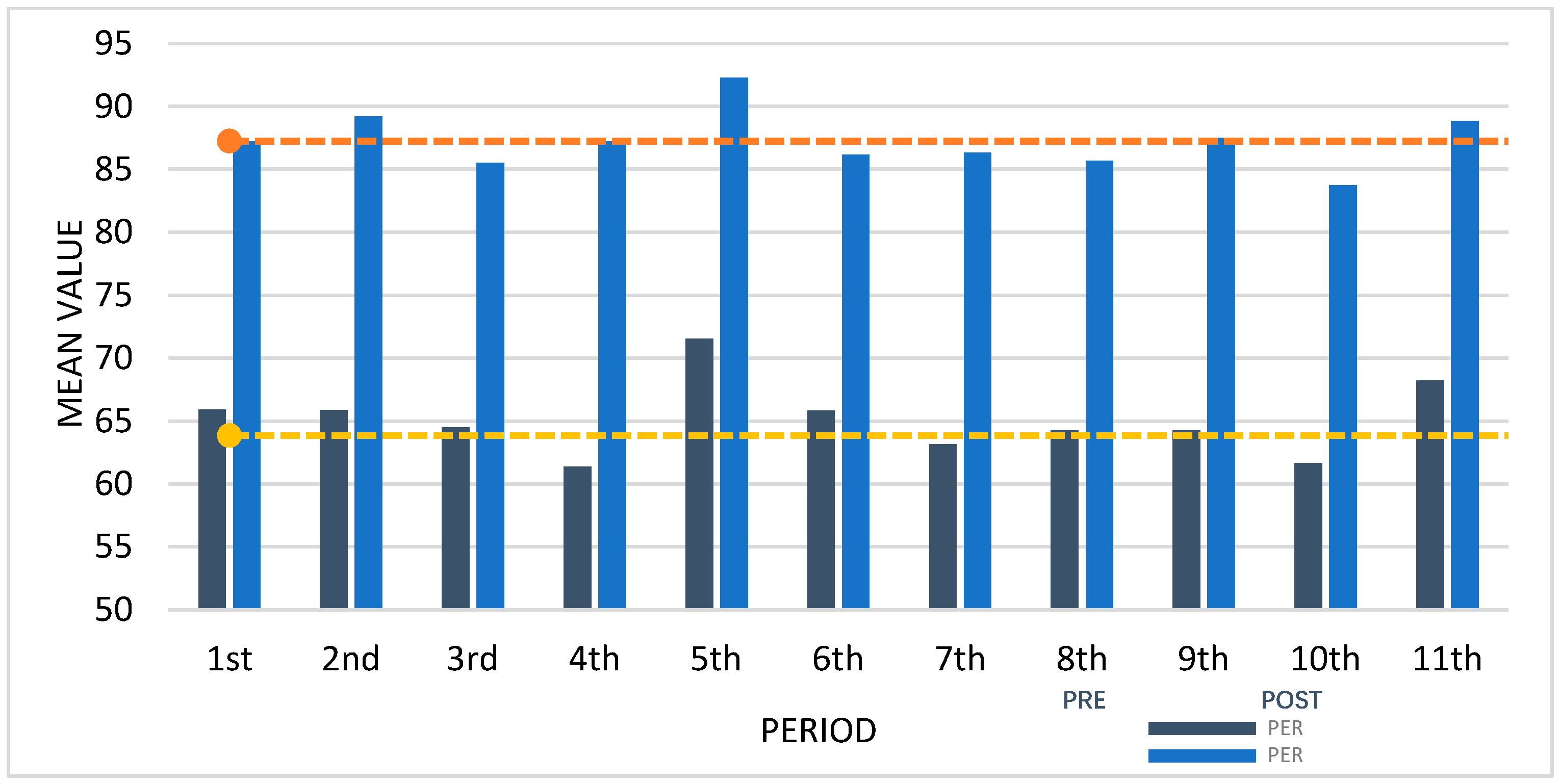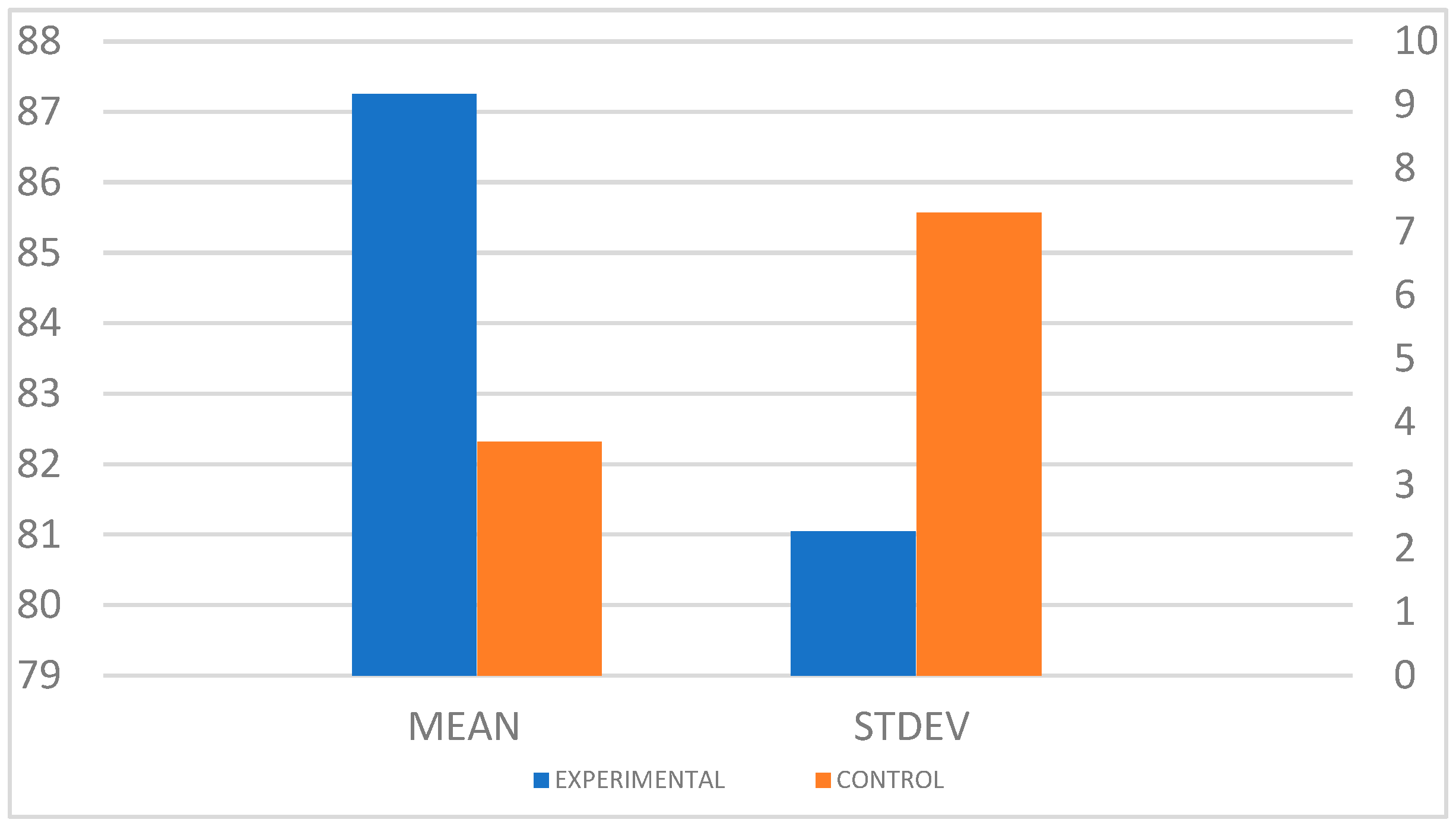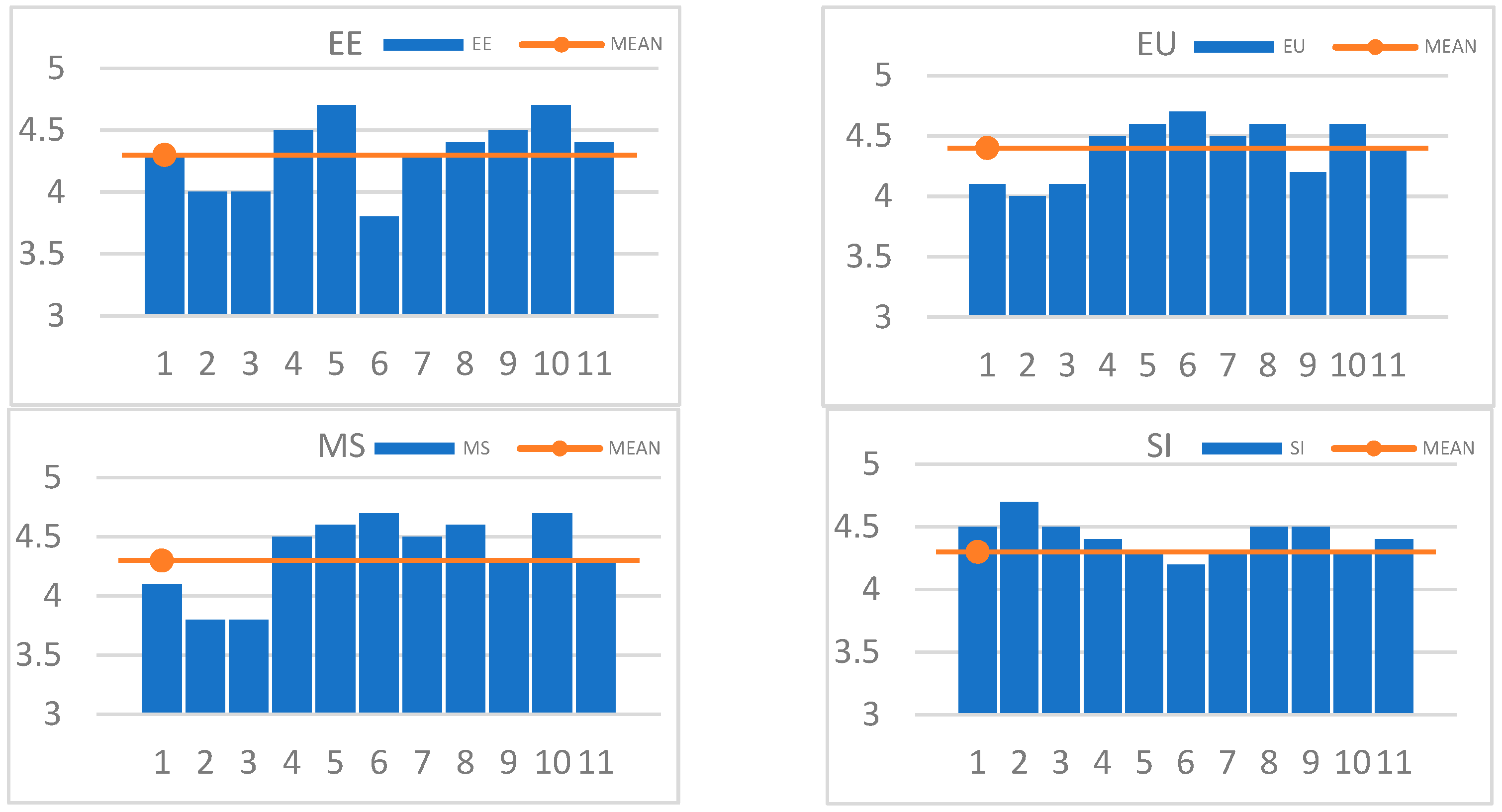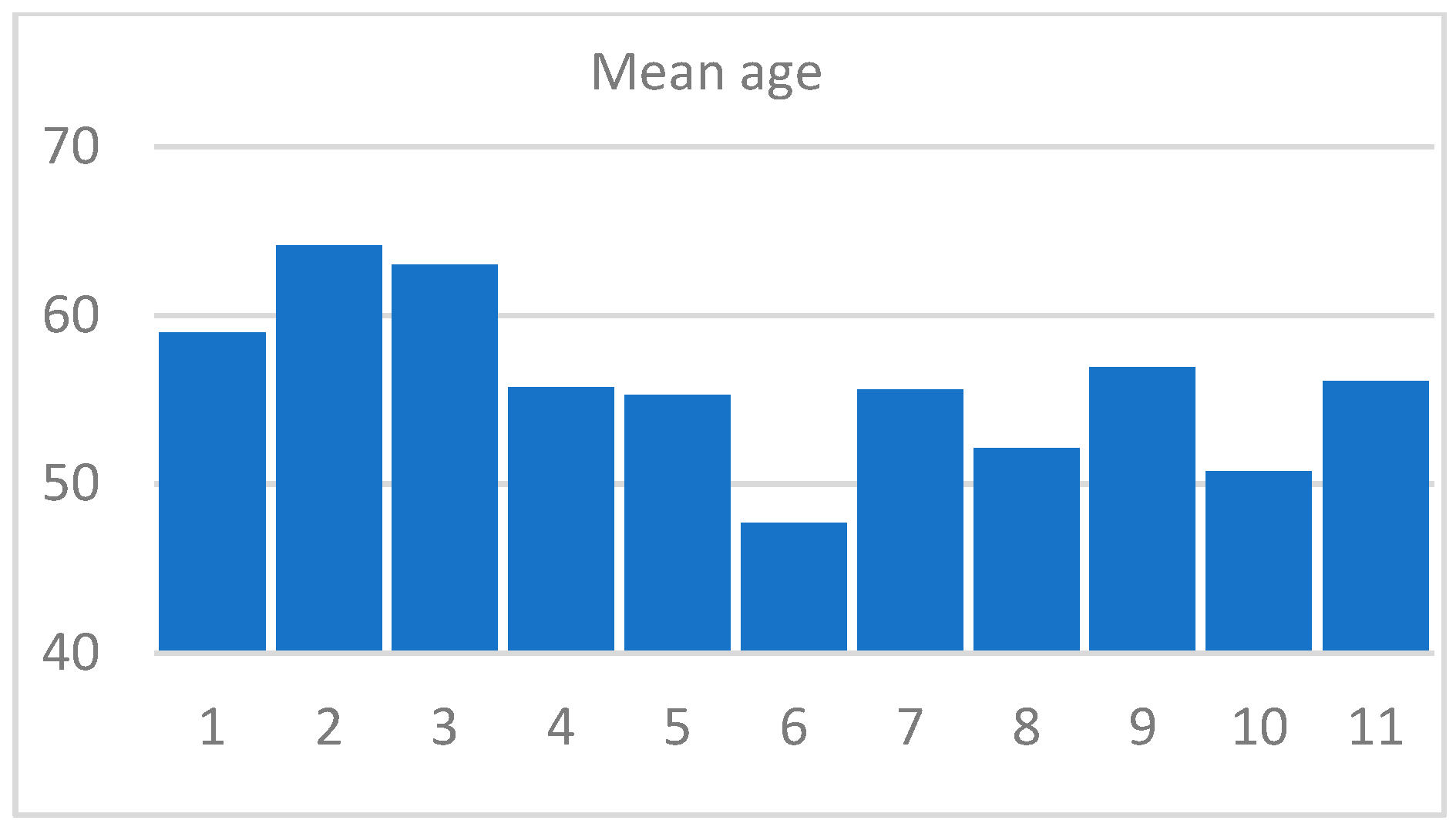1. Introduction
Increasing damage and threats posed by both natural (e.g., the East Japan earthquake and Australian bush fires) and social disasters (e.g., the Sinking of Motor Vessel Sewol and COVID-19) have accelerated the requirement to develop experience-based content for disaster safety education [
1]. Due to its superiority in delivering unique realistic quality and being able to overcome temporal and environmental barriers of traditional classroom and on-site simulation-based training methods [
2], VR in education and training is becoming increasingly widespread [
3]. Advances in wearable HMDs, haptic devices, and high-resolution projection technologies have further accelerated the popularity of immersive disaster training [
4].
VR-based disaster safety training typically requires participants to make their own escape in a set disaster scenario to develop appropriate response skills and obtain relevant scores. For example, Feng Z. et al. (2018) [
5] developed a conceptual framework for the design of immersive serious VR games to deliver knowledge on building evacuation during emergencies, such as fires and earthquakes. Ooi S. et al. (2019) [
6] proposed a fire-focused VR disaster prevention training system. In the study of Bhookan N. S. et al. (2020) [
7], several precautions and response activities that take place before, during, and after an earthquake disaster were introduced as part of VR-based disaster survival training. Studies have shown that VR systems can significantly help reduce risks, increase acceptance, and improve efficiency over traditional training methods [
8].
In prior related studies, participants were all asked to wear an HMD, navigate and interact with wands, and to respond to specific situations in a virtual environment completely out of reality, which is also the first thing that comes to mind when VR is mentioned. However, the common dizziness caused by an HMD is more pronounced in cases of disasters [
9]. With some high-end headsets on the market, such as the Oculus Quest 2, vertigo may be reduced to a lower level, but the price remains very expensive. To implement a highly immersive, real-time virtual disaster training program for multiplayer teams (components of the metaverse), wireless or all-in-one headsets appear to be superior to wired ones, but they have to rely on sophisticated cloud or edge computing algorithms, along with high bandwidths such as cloudXR and 5G [
10].
Moreover, neither disaster preparedness nor resilience is in the hands of one individual, and communication and collaboration are critical to disaster response. Interaction among participants also contributes to deeper engagement in VR-based disaster training. Realizing the diversity of social groups, some studies have also attempted to explore pedagogical approaches for different audiences [
11,
12]. Nevertheless, education for teams remains scarce, and disaster training in teamwork in VR environments should be more popular.
The current study aims to provide a hybrid schema for team disaster training in an immersive environment that combines VR projection and HMD to increase learner motivation, while enhancing the learning of proper escape skills and decision making in the face of disasters. The way to achieve the research objective is to utilize VR projection, HMD, and role-playing techniques to make team-based disaster training usable and interesting, while understanding the responsibilities of personnel and the coordination between different sectors of disaster management.
The paper is organized as follows. First, the background of related technologies is reviewed. Then, the design of a new VR projection-based multidisplay system and team-based role-playing mechanism is introduced. Technical issues encountered, the results of the designed quality assessment, and a user experience survey are subsequently provided. Finally, the conclusion and prospects for future work are presented.
2. Background
VR-based disaster safety training has attracted a growing body of research. The most common feature of VR environments is to expose participants to disaster scenarios which are as realistic as possible, such as earthquakes, fires, floods, epidemics, etc. Once built, they can serve as flexible workstations for training, namely performing assigned tasks from the first perspective, disseminating safety knowledge, as well as being applied to the realm of action [
6].
2.1. VR in Disaster Training
There is a great deal of research on disaster response and relief, either independently or in combination with other forms of training. Aleksandra et al. (2018) [
13] reviewed a series of serious games and simulations on the challenges of disaster risk management and found that serious games and simulations encompassing VR, the virtual world, and role-playing may help raise risk awareness. However, they also demonstrated that neither of them could be considered as a separate risk management approach because of the main limitations of game-play property. Vinh T. Nguyen et al. [
14] presented a VR application to help trainees practice rescue paths in a customized scenario. However, the approach to the transformation of different scenes and the positioning of the first perspective made the participants feel uncomfortable. Additionally, user feedback suggested that the interaction points should be more prominent. Through behavioral modeling, the researchers designed a fire safety training system in a VR environment [
15]. However, the limited mobility of the tool reduced its flexibility, and the scenario was designed to be restricted to student groups, shifting learning to pleasure over expertise. Caballero and Niguidula [
16] proposed a qualitative method to conduct training simulations for various disasters, but the over-gamified design was not suitable for professional training in disaster safety.
The studies cited have shown that in designing a virtual training programme, it is necessary to consider its interactivity, expansion ability, and applicability to various disasters. Furthermore, Parsons and Cobb (2011) [
17] also demonstrated that the skills to be acquired can be further transferred to real-life conditions when the presence in the VR environment is higher. Most approaches to design a VR-based training system tend to design a standalone game [
1,
5,
8,
14,
17]. In contrast, our approach combines virtual experience and role-playing approaches to let the team decide whether to seek refuge first in their own way.
2.2. Immersive VR Projection System
VR is not just headsets; VR projection systems represent another solution. VR projection is also known as an immersive multidisplay system or large full-surround screens. It is realized by projecting multiple projectors from given positions onto the walls of a fixed shape and then smoothly connecting the projected images together [
18]. As disaster safety preparedness and response cannot usually be carried out by a single person, the appeal of being able to share virtual experiences with multiple users simultaneously and provide a unique infrastructure for teamwork may emerge [
19]. Mainstream VR projection systems, such as the VR dome and VR Cave, have proven to be useful learning tools to help strengthen the interaction between participants by providing immersive sensations, as well as reducing per capita training costs for multiple trainees [
20,
21].
One of the technical difficulties of VR projection systems lies in the overall coverage of the customized space and the synchronization of the different images projected by multiple projectors [
22]. The most common way of projection on a large screen is to arrange the projectors in a fixed manner, either vertically, horizontally, or in rings, and to blend the borderlines of each projection [
21,
23]. In addition to ensuring full coverage, overlaying multiple projections can also enhance display resolution for a more immersive experience. The vast majority implement multiscreen synchronization to work, simply configuring an operating system to control a single projector, and considering one as a server to consolidate clients’ deployment [
24,
25,
26,
27]. To simplify the complexity, based on previous studies, we proposed a new VR projection-based multidisplay system, iwDome (immersive wide Dome), combining VR dome and VR cylinder, using an improved network framework for one PC and multiple projectors.
2.3. Role-Playing and Teamwork
Role-playing can serve as an excellent model to facilitate visual teaching in virtual environments and enhance interaction and engagement among participants [
28], while teamwork discourses have a direct impact on how members react [
29]. In a series of works, role-playing has been proven to be helpful in understanding learning points and fostering responsibilities more directly [
30,
31]. Teams’ achievements can far exceed individual stacking, and each member will gain more [
32], that is, effective role-playing and teamwork can contribute to the quality of disaster training.
The most common method for role-playing is to assign a specific role to every participant [
1,
33,
34]. However, for a large number of trainees in a VR environment, this is not easy to achieve due to time and venue constraints. Given this, we proposed a team-based role-playing approach that allows for both role-playing as well as intra-team and inter-team cooperation.
3. The Multidisplay and Role-Playing Based Training System
In the current study, when designing the VR system for disaster training, several special concerns were addressed. In particular, the study aimed to develop a system that does not focus on entertainment but on the propagation of safety information and is suitable for team-based role-playing. Thus, both VR projection-based multidisplay systems and HMDs were selected to build an immersive virtual environment, wherein the multidisplay system was dedicated to the representation of the overall training effect, while the HMD reflected each intra-team training session.
3.1. The Design of iwDome
The promise of immersive training with the VR multidisplay system and HMD combined systems is that they are both fun and real, providing immediate feedback, and enabling groups of users to share or experience a realistic environment without completely separating all participants from the real world [
35,
36]. Compared to cube-like systems such as VR Cave, both VR dome and cylinder can provide more interaction space [
36], and the avoidance of corners and edges in the structure can also confirm the non-distortion of perception [
37]. Our work is based on [
21,
26], which arranges projections into shapes of 3D space and overlaps the edges of adjacent projections. Subsequently, the server–client network method synchronizes the multiscreen display. In general, generic multidisplay building approaches do not leverage the fact that, ultimately, utilizing available space can expand the accommodation capacity.
For the purpose and feasibility of conducting a specialized disaster safety training system, we did not adopt the full 360-degree spatial model, but only built half to display the VR content, leaving the rest for audience hosting and other functional configurations.
Figure 1 shows the schematic layout diagram and specifications of the iwDome system. To avoid scattering the entire image, six projectors with edge-blending functionality [
38] were positioned vertically and in cross-projection, four for the upper dome and two for the bottom cylinder, which all connected to their respective Win 10 operating systems by connecting hubs. It is worth mentioning that we only used two operating systems to configure a total of six projectors.
The physical appearance of the iwDome system is depicted in
Figure 2a, and its edge was marked manually for easy viewing. The six black boxes correspond to a set of projectors, vertically mounted at the ends of the large screen, with a group of three. The edge-blending method for overlapping the output edges is shown in
Figure 2b; the matrix edge overlap feature kept the brightness consistency of the overlap and the rest. We set different positions and angles for the projectors, as well as the viewport rectangles, and adjusted the projection scopes as part of the 3D display, as shown in
Figure 3, where a–d are the upper-left to lower-right projection views of the upper dome, e and f are the left and right projection views of the bottom cylinder, and g shows the composite output.
Elements that can cause multiscreen synchronization delays in scenario-based disaster training include scene conversion, animation, and video playback. The server’s role in the synchronization network is primarily the processing of messages received from input devices connected to clients and distributing results and commands. Excessive reliance on the server reduces the computing speed and performance of the system, thus affecting the experience. Loading large assets into virtual scenarios can also consume large amounts of resources. Considering this, we adopted the Unet technology due to its ease of use and maintenance advantages [
39,
40]. Only when the server receives requests from all clients will the command be processed, and the clients will execute their own response, as shown in
Figure 4. The implementation involves configuring one of the operating systems as a host, a combination of server and client, and others as secondary clients, and the display on the clients will only change if the server emits a command. Each step in the calculation is performed by the client themselves, such as invoking certain models during execution, which can not only lighten the load on the server but also lower sync latency. To this end, we preloaded large models or videos into memory prior to network communication to reduce potential latency problems between different clients due to different processor processing capabilities. The proposed mechanism for sharing the same code set of host and other clients allows for the rapid testing of synchronization issues for non-large LAN projects.
3.2. Role-Based Team Training
Role-playing is an interactive way to enhance VR disaster training, which has been proven to be a more preferable and sustainable response in emergency training [
41]. Instead of using the traditional VR role-playing methods that emphasize role manipulation by a single player, we propose assigning roles to teams to simulate different sectors of disaster safety management. This not only ensures collaboration across roles, but also supports internal communication within the same team, that is, in disaster training, we aim to train individual responsiveness and teamwork skills.
Taking the virtual school earthquake scenario as an example, the roles of students, lecturer, principal, health teacher, and PE teacher can be randomly assigned to different teams, corresponding to the responsibilities of self-protection, personnel evacuation, overall organization, rescue, and logistical support in the disaster safety management system, as shown in
Figure 5. At first, different roles are set in different initial places, such as a classroom or corridor, with the common goal of taking refuge in the playground. During the training, violent shaking, falling objects, fires, injuries, disappearances, and other emergencies may occur, requiring each team to properly decide how its role should react, cooperate, or guide other roles. Training results are expressed in survival rates, with five monitors to show the training progress of each team, while the corresponding role is controlled by a team representative wearing the HMD, and the iwDome system is used to show global progression and survival.
To realize synchronization between teams and the iwDome system, each subsystem must be embedded as a client in the network structure, as shown in
Figure 6. Given that PCVR can not only deliver the best user experience but also synchronize the display to a connected monitor, it is selected as the appropriate HMD suitable for collaboration within the team. Takashi Komura [
42] proposed a similar role-playing-based disaster training approach for teams, but the use of a large map and imagination prevented a realistic experience.
4. User Study
The system proposed is intended to improve user satisfaction and general user motivation for VR-based disaster training programs. To continuously refine the proposed disaster training schema, a user study of the school earthquake training course was developed, which took the feedback data from a total of 11 period quizzes and user experience surveys.
4.1. Participants
Participants could voluntarily apply through the official website, limited to civil servants or staff involved in disaster relief management, with a maximum of 30 people per period. Most of them were in their 40s and 50s and concerned themselves more with the dissemination of skills than with entertainment. Of a total of 231 participants, 199 samples were retained after excluding those who failed to complete the quiz or survey, with a male-to-female ratio of approximately 4:1.
4.2. Training Procedure
Participants were randomly assigned to five teams and, after a brief introduction to the training system, a pre-quiz was given to measure the baseline level of their earthquake safety knowledge. Next, one representative from each team was selected to enter the virtual world wearing both the HMD and haptic devices [
43], and then, the other members observed the same view via the connected monitors and iwDome. Participants were expected to work with intra-team and inter-team members to complete the refuge, and collaboration between teams depended on the relationships between roles, for example, the student role required guidance from the teacher’s role before taking action. Afterward, a post-quiz and user experience survey were conducted to assess the training performance.
Figure 7 illustrates the steps involved in training.
4.3. Experimental Results
The quizzes used to measure the participants’ disaster management capabilities were developed based on the knowledge intended to be conveyed by the training schema created by the disaster safety education experts. It was expressed in centesimal grades and consisted of 24 single-choice questions, with two to five options each, and was set to 4 or 5 points. The average scores of the pre- and post-quiz for each period are plotted in the histogram of
Figure 8, and the two dashed lines indicate the mean values of all periods. The results show that the average rating after the VR-based disaster safety training was generally increased by about 20–25 points, demonstrating that the proposed training schema facilitates the dissemination of knowledge on disaster management.
The control group came from a PPT and video-based training program that was disengaged from the VR-based training and was provided by the quiz design experts. A total of 60 participants enrolled in the study, and by incorporating the maximum and minimum scores into the linear congruential generator algorithm [
44], we augmented the data to 199, the same number in the experimental group. The results reveal that, as shown in
Figure 9, the experimental group was on average about 5 points higher than the control group, and a smaller deviation suggests that VR-based training may be less susceptible to objective factors such as attention.
4.4. User Experience Survey Results
The user experience survey required participants to demonstrate their satisfaction with iwDome and the role-based team training in several aspects: EE (educational effectiveness), EU (ease of use), MS (motion sickness), and SI (scenario immersion), of which, EE asked participants to rank how helpful the gained knowledge was in their daily work; EU asked for an estimate of how easily the system is understandable; MS asked participants to assess motion sickness; and the realism and immersion involved in the virtual scenario were required to be ranked for SI. Each item could be ranked from 1 to 5, with 5 indicating the highest positive level.
Figure 10 shows the distribution of the survey results, and
Figure 11 gives the average age of participants in each training period. The results reveal that younger participants are less sensitive to the motion of sickness but require higher levels of immersion and enjoyment in the virtual experience. Given that motion sickness and scenario immersion are key factors in investigating the rational design of a VR system, further validation of the effects derived from age is warranted.
Table 1 shows a significant negative correlation of age with SM and a positive correlation with SI. Therefore, future optimization can consider the applicability of different age groups. In the final open-ended part of the survey, some participants reflected that haptic devices and team interactions throughout the experience contributed to an increased sense of engagement. Some argued that educational time should be extended to cover different roles and types of disasters. However, some responded that the lack of sound insulation between teams sometimes affected the exchange of opinions, and some were hoping that the iwDome system could be further developed to completely replace the use of monitors.
5. Conclusions
Disaster safety training comes in many forms, from theory to on-site practice, but the most basic common goal is to raise awareness about disasters, especially for children and adolescents. VR applications provide the means to translate theory into reality and to develop disaster safety skills in a secure environment. However, a comprehensive disaster safety management system requires cooperation and coordination between different sectors and roles. Therefore, this paper puts forward the schema of role-playing and team training in the VR system.
To realize team-based virtual training, we propose the iwDome system to achieve the global presentation of training results. The advantages of combining the traditional VR dome with a cylinder can simultaneously guarantee the lower distortion of images and a large enough space. A Unet-technology-based network was built to optimize the previous one-to-one configuration of the projector and PC to multiple-to-one. Both iwDome and HMDs contributed to the implementation of team-based role training, and the user study suggested that immersive VR systems with intra-team and inter-team interactions show significant improvements in training quality over tedious PPT- or video-based methods. The study also indicates that age influences feedback on engagement in perception and motion sickness. Therefore, targeted grouping methods and disaster scenario designs might be needed to improve the system flexibility on VR intensity and realism for different age groups.
The current iwDome system was only used to present the global collaborative training results and did not fully encapsulate every team scene, mainly depending on the limitation of venue, resolution, and visual comfort for all participants. The inclusion of all scenes on a large VR screen means greater capacity, as displaying more content in a small area means resolution is sacrificed. How to present a large screen to all participants seated in designed positions with a comfortable perspective is another issue to consider. Furthermore, a validity assessment of the learning benefits of iwDome versus other VR systems may be needed in future studies. A post hoc retention rate of disaster safety knowledge due to the schema in comparison with other traditional training techniques also requires further investigation.
People are often overwhelmed by unpredictable disasters, and disaster safety training helps to raise awareness of disaster response skills. The acquisition of theoretical knowledge is often boring and lacks empathy, whereas on-site practice is limited by the potential hazards and singularity. In recent years, VR technology has become more widely promoted with the diffusion of COVID-19. Beyond individual-focused VR disaster simulators, there are very few disaster safety training programs available which incorporate teamwork. The proposed VR multidisplay system and team-based role-playing schema provide a reference for research in this field and expand VR-based disaster safety training for adults. The findings demonstrate significant progress in strengthening disaster safety training for disaster managers.
Author Contributions
Conceptualization, Y.X.; methodology, Y.X.; software, Y.X.; formal analysis, Y.X. and Y.D.; data curation, Y.X. and Y.D.; writing—original draft preparation, Y.X.; writing—reviewing and editing, Y.D. All authors have read and agreed to the published version of the manuscript.
Funding
Funding for this paper was provided by Namseoul University.
Institutional Review Board Statement
Not applicable.
Informed Consent Statement
Informed consent was obtained from all subjects involved in the study.
Data Availability Statement
Data sharing is not applicable.
Conflicts of Interest
The authors declare no conflict of interest.
References
- Haferkamp, N.; Kraemer, N.C.; Linehan, C.; Schembri, M. Training disaster communication by means of serious games in virtual environments. Entertain. Comput. 2011, 2, 81–88. [Google Scholar] [CrossRef]
- Hsu, E.B.; Li, Y.; Bayram, J.D.; Levinson, D.; Yang, S.; Monahan, C. State of Virtual Reality Based Disaster Preparedness and Response Training. PLoS Curr. 2013, 5, 1–6. [Google Scholar] [CrossRef] [PubMed]
- Pedram, S.; Ogie, R.; Palmisano, S.; Farrelly, M.; Perez, P. Cost–benefit analysis of virtual reality-based training for emergency rescue workers: A socio-technical systems approach. Virtual Real. 2021, 25, 1071–1086. [Google Scholar] [CrossRef]
- Kreimeier, J.; Hammer, S.; Friedmann, D.; Karg, P.; Bühner, C.; Bankel, L.; Götzelmann, T. Evaluation of different types of haptic feedback influencing the task-based presence and performance in virtual reality. In Proceedings of the 12th ACM International Conference on PErvasive Technologies Related to Assistive Environments, New York, NY, USA, 5–7 June 2019; pp. 289–298. [Google Scholar] [CrossRef]
- Feng, Z.; González, V.A.; Amor, R.; Lovreglio, R.; Cabrera-Guerrero, G. Immersive virtual reality serious games for evacuation training and research: A systematic literature review. Comput. Educ. 2018, 127, 252–266. [Google Scholar] [CrossRef]
- Ooi, S.; Tanimoto, T.; Sano, M. Virtual reality fire disaster training system for improving disaster awareness. In Proceedings of the 2019 8th International Conference on Educational and Information Technology, Cambridge, UK, 2–4 March 2019; pp. 301–307. [Google Scholar]
- Bhookan, N.S.; Murde, M.S.; Thakur, D.P.; Jadhav, H.B. Disaster Survival Training Using Virtual Reality. In Proceedings of the 2020 5th International Conference on Computing, Communication and Security (ICCCS), Patna, India, 14–16 October 2020; pp. 1–4. [Google Scholar]
- Smith, S.; Ericson, E. Using immersive game-based virtual reality to teach fire-safety skills to children. Virtual Real. 2009, 13, 87–99. [Google Scholar] [CrossRef]
- Kim, H.K.; Park, J.; Choi, Y.; Choe, M. Virtual reality sickness questionnaire (VRSQ): Motion sickness measurement index in a virtual reality environment. Appl. Ergon. 2018, 69, 66–73. [Google Scholar] [CrossRef]
- Kim, W.S. Edge computing server deployment technique for cloud VR-based multi-user metaverse content. J. Korea Multimed. Soc. 2021, 24, 1090–1100. [Google Scholar]
- Adams, R.M.; Karlin, B.; Eisenman, D.P.; Blakley, J.; Glik, D. Who participates in the Great ShakeOut? Why audience segmentation is the future of disaster preparedness campaigns. Int. J. Environ. Res. Public Health 2017, 14, 1407. [Google Scholar] [CrossRef]
- Vijaykumar, S.; Jin, Y.; Rogerson, D.; Lu, X.; Sharma, S.; Maughan, A.; Fadel, B.; de Oliveira Costa, M.S.; Pagliari, C.; Morris, D. How shades of truth and age affect responses to COVID-19 (Mis) information: Randomized survey experiment among WhatsApp users in UK and Brazil. Humanit. Soc. Sci. Commun. 2021, 8, 88. [Google Scholar] [CrossRef]
- Solinska-Nowak, A.; Magnuszewski, P.; Curl, M.; French, A.; Keating, A.; Mochizuki, J.; Liu, W.; Mechler, R.; Kulakowska, M.; Jarzabek, L. An overview of serious games for disaster risk management—Prospects and limitations for informing actions to arrest increasing risk. Int. J. Disaster Risk Reduct. 2018, 31, 1013–1029. [Google Scholar] [CrossRef]
- Nguyen, V.T.; Jung, K.; Dang, T. VRescuer: A Virtual Reality Application for Disaster Response Training. In Proceedings of the 2019 IEEE International Conference on Artificial Intelligence and Virtual Reality (AIVR), San Diego, CA, USA, 9–11 December 2019; pp. 199–202. [Google Scholar] [CrossRef]
- Çakiroğlu, Ü.; Gökoğlu, S. Development of fire safety behavioral skills via virtual reality. Comput. Educ. 2019, 133, 56–68. [Google Scholar] [CrossRef]
- Caballero, A.R.; Niguidula, J.D. Disaster risk management and emergency preparedness: A case-driven training simulation using immersive virtual reality. In Proceedings of the 4th International Conference on Human-Computer Interaction and User Experience in Indonesia, CHIuXiD’ 18, New York, NY, USA, 23–29 March 2018; pp. 31–37. [Google Scholar] [CrossRef]
- Parsons, S.; Cobb, S. State-of-the-art of virtual reality technologies for children on the autism spectrum. Eur. J. Spec. Needs Educ. 2011, 26, 355–366. [Google Scholar] [CrossRef]
- Takatori, H.; Hiraiwa, M.; Yano, H.; Iwata, H. Large-scale projection-based immersive display: The design and implementation of largespace. In Proceedings of the 2019 IEEE Conference on Virtual Reality and 3D User Interfaces (VR), Osaka, Japan, 15 August 2019; pp. 557–565. [Google Scholar]
- Blom, K.; Lindahl, G.; Cruz-Neira, C. Multiple active viewers in projection-based immersive environments. In Proceedings of the Immersive Projection Technology Workshop, Orlando, FL, USA, 24–28 March 2002; pp. 1–5. [Google Scholar]
- Tzanavari, A.; Matsentidou, S.; Christou, C.G.; Poullis, C. User experience observations on factors that affect performance in a road-crossing training application for children using the CAVE. Springer Lecture Notes in Computer Science 2014, 8524, 91–101. [Google Scholar] [CrossRef]
- Li, S.; Huang, Y.; Tri, V.-S.; Elvek, J.; Wan, S.; Kjallstrom, J.; Andersson, N.; Johansson, M.; Lejerskar, D. Interactive theater-sized dome design for edutainment and immersive training. In Proceedings of the 2014 Virtual Reality International Conference, 9–11 April 2014; pp. 1–5. [Google Scholar] [CrossRef]
- Kuchera-Morin, J.; Wright, M.; Wakefield, G.; Roberts, C.; Adderton, D.; Sajadi, B.; Höllerer, T.; Majumder, A. Immersive full-surround multi-user system design. Comput. Graph. 2014, 40, 10–21. [Google Scholar] [CrossRef]
- Koide, D.; Kawakita, H.; Yoshino, K.; Ono, K.; Hisatomi, K. Development of High-Resolution Virtual Reality System by Projecting to Large Cylindrical Screen. In Proceedings of the 2020 IEEE International Conference on Consumer Electronics (ICCE), Las Vegas, NV, USA, 4–6 January 2020; pp. 1–6. [Google Scholar] [CrossRef]
- Gonçalves, A.; Bermúdez, S. KAVE: Building Kinect based Cave automatic virtual environments, methods for surround-screen projection management, motion parallax and full-body interaction support. In Proceedings of the ACM on Human-Computer Interaction, New York, NY, USA, 19 June 2018; pp. 1–15. [Google Scholar]
- Cruz-Neira, C.; Reiners, D.; Springer, J.P. An affordable surround-screen virtual reality display. J. Soc. Inf. Disp. 2010, 18, 836–843. [Google Scholar] [CrossRef]
- Yuen, K.K.; Choi, S.H.; Yang, X.B. A Full-immersive CAVE-based VR Simulation System of Forklift Truck Operations for Safety Training. Comput. Des. Appl. 2010, 7, 235–245. [Google Scholar] [CrossRef]
- Li, W.-J.; Chang, C.-C.; Hsu, K.-Y.; Kuo, M.-D.; Way, D.-L. A PC-based distributed multiple display virtual reality system. Displays 2001, 22, 177–181. [Google Scholar] [CrossRef]
- Park, K.-M.; Ku, J.; Choi, S.-H.; Jang, H.-J.; Park, J.-Y.; Kim, S.I.; Kim, J.-J. A virtual reality application in role-plays of social skills training for schizophrenia: A randomized, controlled trial. Psychiatry Res. 2011, 189, 166–172. [Google Scholar] [CrossRef]
- Selvaraj, S.; Sandaran, S.C. Discourses of Flood Disaster Preparedness by NGOs: Humanitarian Aid, Teamwork and Victimization. GEMA Online J. Lang. Stud. 2019, 19, 111–127. [Google Scholar] [CrossRef]
- Hidayati, L.; Pardjono, P. The implementation of role play in education of pre-service vocational teacher. IOP Conf. Series Mater. Sci. Eng. 2018, 296, 012016. [Google Scholar] [CrossRef]
- Spyropoulos, F.; Trichakis, I.; Vozinaki, A.E. A Narrative-Driven Role-Playing Game for Raising Flood Awareness. Sustainability 2022, 14, 554. [Google Scholar] [CrossRef]
- Božović, M.; Živković, S. Teamwork and efficient communication as the elements of the system for emergency management. Facta Univ. Ser. Work. Living Environ. Prot. 2015, 12, 381–395. Available online: https://pdfs.semanticscholar.org/6e02/f16e545a182f91c6ec60a9007feb4d36a2c7.pdf (accessed on 30 August 2022).
- Kusumawati, I.M.; Fauziah, A.N.M. Validity and Practucality of Students Worksheets in Disaster Mitigation through Role-playing Method to Train Disaster Management. PENSA E-J. Pendidik. Sains 2020, 8, 209–217. [Google Scholar]
- Taukhid, M.; Hayati, F.; Alfiana, Y.T. Students’ First-Aid Ability in Earthquake Disasters Significantly Improved through an Online Role-Playing Method. J. Appl. Nurs. Heal. 2021, 3, 84–89. [Google Scholar] [CrossRef]
- WorldViz. Available online: https://www.worldviz.com/post/virtual-reality-projection-solutions-for-research (accessed on 6 June 2021).
- Sanz, F.A.; Olivier, A.-H.; Bruder, G.; Pettre, J.; Lecuyer, A. Virtual proxemics: Locomotion in the presence of obstacles in large immersive projection environments. In Proceedings of the 2015 IEEE Virtual Reality (VR), Arles, France, 23–27 March 2015; pp. 75–80. [Google Scholar] [CrossRef]
- VR Projection Room vs VR Projection Dome. Fulldome Pro. 2022. Available online: https://fulldome.pro/blog/vr-projection-room-vs-vr-projection-dome/ (accessed on 2 August 2022).
- Edge Overlap with M-Series: Simplify Multi-Projector Edge Blending. Available online: https://www.matrox.com/en/video/products/graphics-cards/m-series/powerdesk/edge-overlap#affordable (accessed on 1 August 2022).
- Ahde, J. Real-time Unity Multiplayer Server Implementation. Bachelor’s Thesis, South-Eastern Finland University of Applied Sciences, Kotka, Finland, 2017. Available online: https://www.theseus.fi/bitstream/handle/10024/136944/Ahde_Jani.pdf?sequence=1 (accessed on 30 August 2022).
- Ampbell, A.G.; Santiago, K.; Hoo, D.; Mangina, E. Future mixed reality educational spaces. In Proceedings of the 2016 Future Technologies Conference (FTC), San Francisco, CA, USA, 6–7 December 2016; pp. 1088–1093. [Google Scholar] [CrossRef]
- Aghababaeian, H.; Sedaghat, S.; Tahery, N.; Moghaddam, A.S.; Maniey, M.; Bahrami, N.; Ahvazi, L.A. A Comparative Study of the Effect of Triage Training by Role-Playing and Educational Video on the Knowledge and Performance of Emergency Medical Service Staffs in Iran. Prehospital Disaster Med. 2013, 28, 605–609. [Google Scholar] [CrossRef] [PubMed]
- Takashi KOMURA. For More Safer Kathmandu Valley Disaster Imagination Game(DIG) Manual for Nepalese People. Report of JICA Study Team on KV EQ Disaster Mitigation Planning, Nepeal, February 2002. pp. 18–30. Available online: https://openjicareport.jica.go.jp/pdf/11685823_09.pdf (accessed on 30 August 2022).
- Wearable Haptic Suit. 2020. Available online: https://www.bhaptics.com/ (accessed on 1 February 2022).
- Apdilah, D.; Harahap, M.K.; Khairina, N.; Husein, A.M. A Comparison of One Time Pad Random Key Generation using Linear Congruential Generator and Quadratic Congruential Generator. J. Physics: Conf. Ser. 2018, 1007, 012006. [Google Scholar] [CrossRef]
| Publisher’s Note: MDPI stays neutral with regard to jurisdictional claims in published maps and institutional affiliations. |
© 2022 by the authors. Licensee MDPI, Basel, Switzerland. This article is an open access article distributed under the terms and conditions of the Creative Commons Attribution (CC BY) license (https://creativecommons.org/licenses/by/4.0/).
